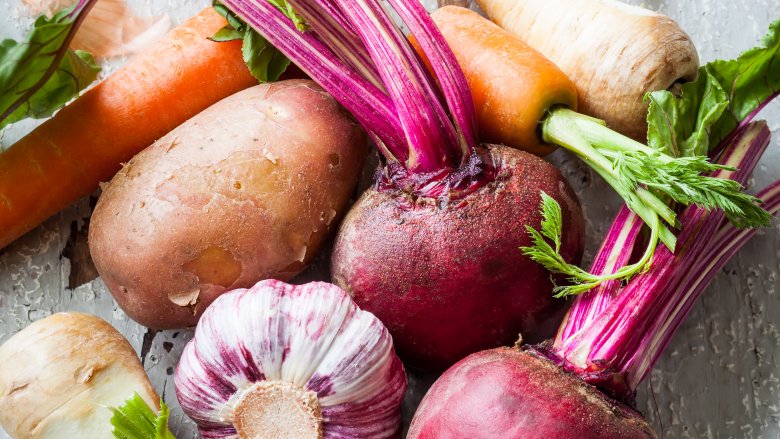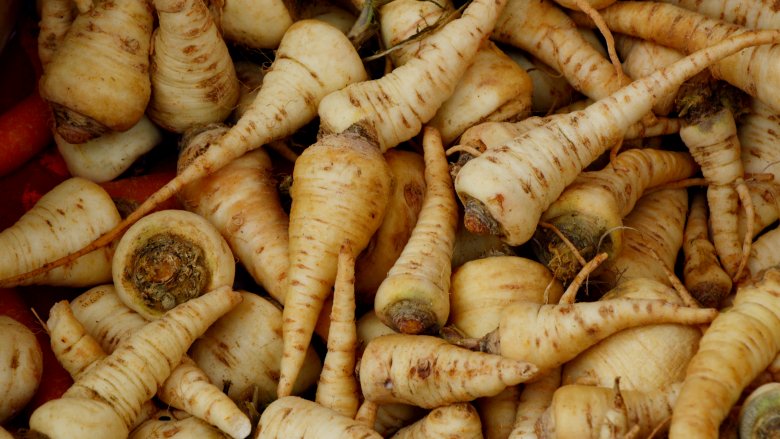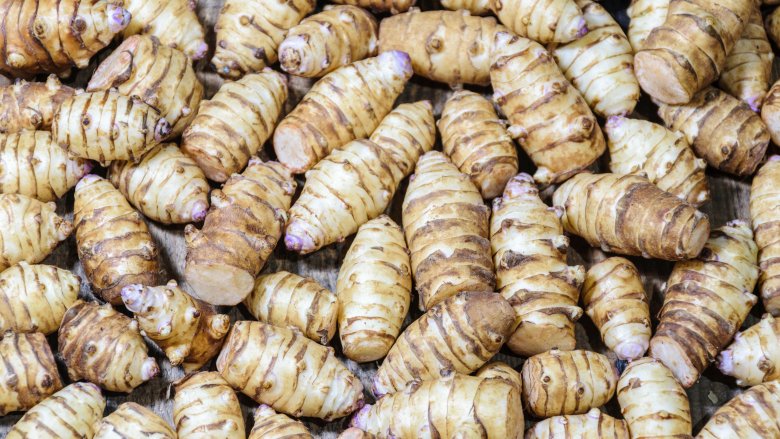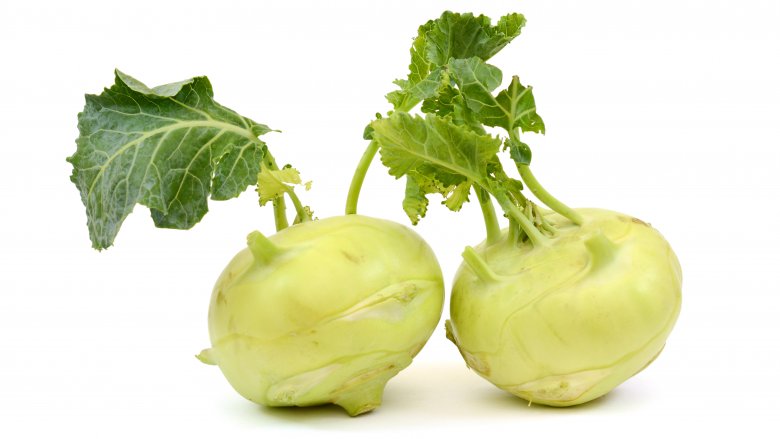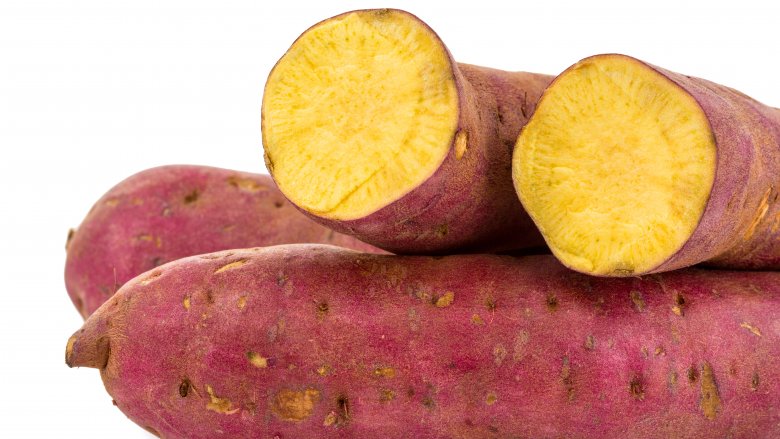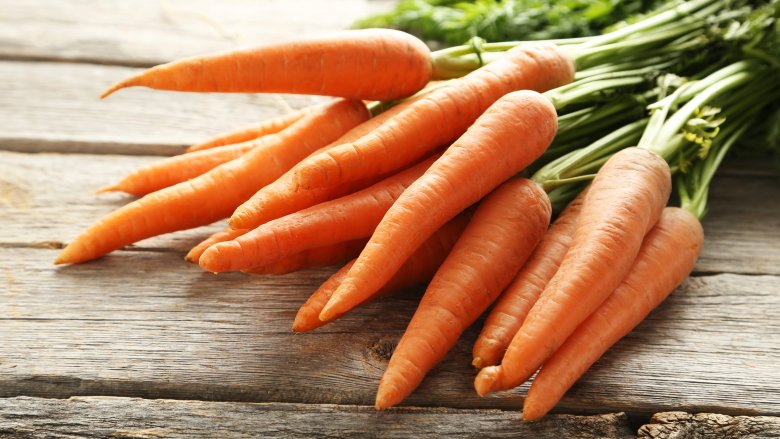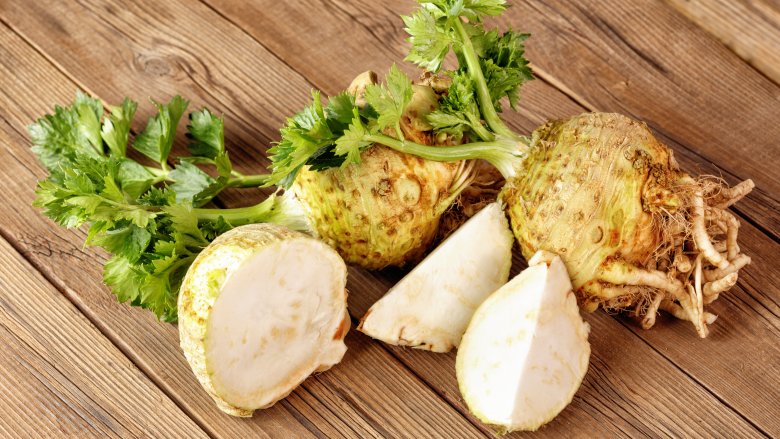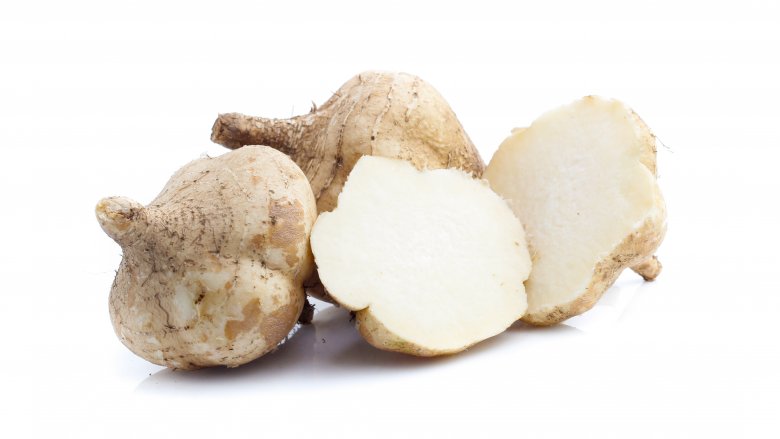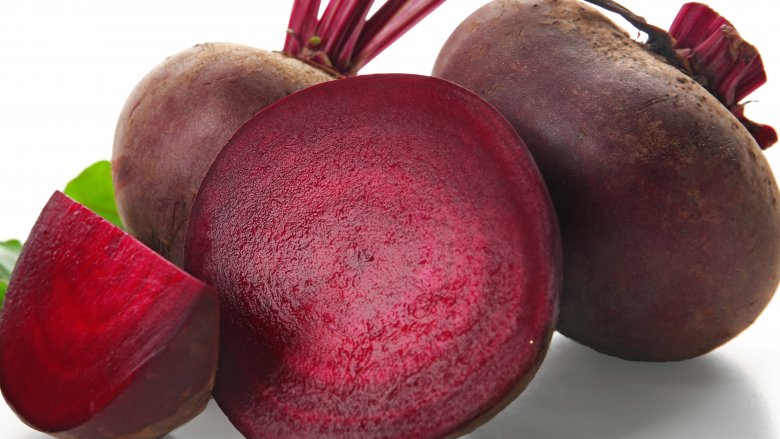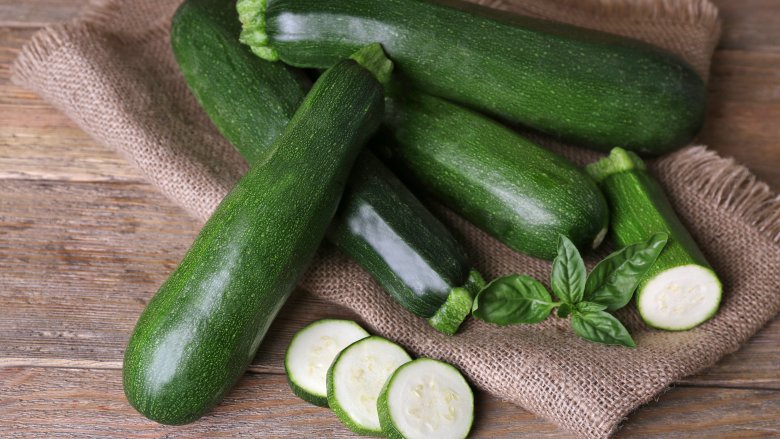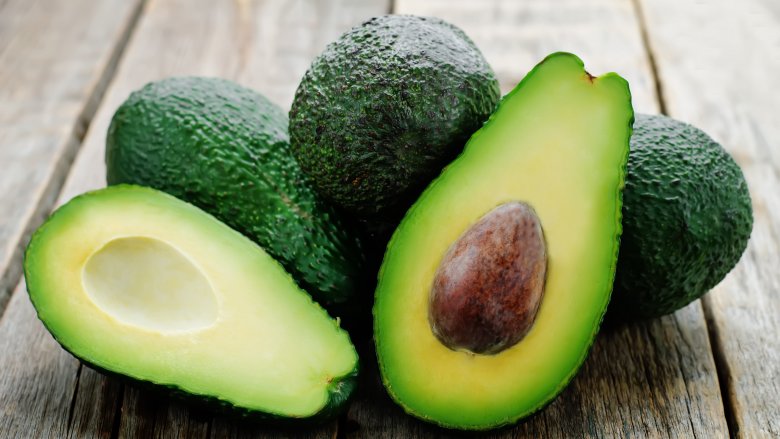Vegetables You Didn't Know Could Be Turned Into Fries
America loves their French fries. And why wouldn't they? They're crispy, crunchy, salty, buttery dipping sticks from heaven. The problem is, they're right up there with deep dish pizza and corn dogs on the good-for-you scale. Eek. But McDonald's doesn't have to have the last word here. If you have access to a grocery store, an oven, and the cojones to try something totally different, then we have several alternatives to French fries that are not only good, they're good for you.
Parsnip fries
They look like albino carrots, but they can taste even sweeter — if you cook them right. Parsnips are root vegetables, and they're as good for your stomach as they are for your taste buds.
The parsnip is a great source of fiber. That means it can also help you feel fuller longer, discouraging you from extra grazing throughout the day, and ultimately looser pants.
The key to making them into delicious fries? Size matters. Yes, the bigger the parsnip, the more flavorful. One thing to note, though — the really big ones have a pretty thick, woody core. Make sure to cut it out when cutting up your parsnip into fry-like sticks. After you've peeled them, cut them, and tossed them in a high-heat cooking oil (like ghee or coconut oil), stick them in the oven for approximately 30 minutes (turning halfway through).
Sunchoke fries
Ugly name. Funky look. But beautiful flavor. The sunchoke also goes by the name Jerusalem Artichoke, which is fitting because they kind of taste like an artichoke-flavored potato. These babies have more potassium than a banana, loads of vitamin C, and tons of B-vitamins.
Now that you're solid on the why you should eat them, let's get them into fry form so we can indulge. The best thing about the prep work is that you don't have to peel the skins (woohoo!). Just scrub them with a veggie brush and cut them into sticks. Then, toss them in olive oil or ghee — maybe even some garlic and fresh herbs. Don't forget to add the salt before sticking them in the oven.
Word of warning before you go too crazy on the sunchoke fries. They contain a prebiotic fiber called inulin which some people have a hard time digesting. The result? Gas and bloating. Ugh. Our advice: Mix it with another veggie fry on this list like parsnips or sweet potatoes so you can better control your intake.
Kohlrabi fries
Kohl-whaaat? So it's not quite as popular as broccoli and Brussels sprouts. But it is bred from the same species (the wild cabbage). If you have a farmers market in your area, you most likely have access to kohlrabi — at least during the warmer seasons. Next time you're in your grocery store, take a peek to see if it's there too. It might just be.
Kohlrabi is a card-carrying member of the cruciferous vegetable family. Not only is it high in fiber, studies have shown it's an inflammation-fighter, and it has the potential to cause a reduction in blood sugar.
But perhaps most important to any fry candidate is the fact that it's delicious. Earthy and sweet, with a bit of a bite — kind of like cabbage and jicama had a baby. Though often used raw in slaws or salads, something magical happens when you peel off the skin and slice it into straight little soldiers. You get the makings of a surprisingly satisfying fry. Roasting the kohlrabi really brings out its sweetness. So toss it in coconut oil, add some salt — and if you're really feeling adventurous, some chili powder and cumin — and roast away.
Japanese sweet potato fries
Regular old sweet potato fries are so five years ago. The new kid on the block is the Japanese sweet potato. They stand out like a sore thumb in the sweet potato display at the grocery store because they have a beautiful purple skin. On the inside, you'll find a butter-colored flesh that is sweet in taste, but a little starchier than the regular sweet potato.
This makes it the perfect candidate for a fry. Because unlike the sweet potato that can sometimes feel a bit too soft and mushy, the Japanese version is sturdy and hearty. Plus, they're low maintenance because there's no need to peel the skin. Making fries is as easy as chop, oil, season, and bake. Of course, you can also get fancy by adding nori crisps and serving with a side of wasabi aioli. Oooohhh.
As far as their benefits go, they are on par with the rest of the sweet potato family in vitamin C, B vitamins, potassium, and fiber. What makes them a cut above the rest is a special antioxidant called anthocyanins that's unusual to find in most food sources.
Carrot fries
Up until now, we've been playing it safe, baking your fries so you can feel good about what you're eating. But what would a fry article be without frying? Sure, it'll take a little more work, but we promise, you won't be sorry. The Food Network can show you how it's done. But keep in mind that there is a way to make this dish a little more nourishing, and a little less sinful.
The secret is in the oil. You see, part of what makes a junk food so "junky" is the factory-produced vegetable oil it's fried in. Since you're making these puppies at home, why not use an oil that can hold up to the heat, but offers much more nutrients? Naturally saturated fats such as duck fat, ghee, and coconut oil stay stable at high temperatures, but also are beneficial for optimal health.
Celery root fries
Yet another member of the ugly vegetable club pulls through for us in the end.
Celeriac is a root vegetable, but it is not the root of celery. It definitely has some of its flavor (as it is a relative), but the texture is that of a creamy, starchy potato. To make the fry, you're going to chop off the roots, then shave off the bumpy, uneven skin. Once you see clean, white flesh, you're ready to rumble. Cut the bulb into flat discs, followed by fry-like sticks, roll them in the good oil, salt and season, and you're good to go.
Oh, and let's not forget, like any dutiful vegetable fry, it comes with benefits. The celeriac is famous for its high fiber content, and for being a great source of vitamin B6, which you need for cardiovascular, digestive, immune, muscular, and nervous system function.
Jicama fries
If you've ever dipped a piece of raw jicama in guacamole, you know this tuberous root is incredibly addicting and satisfying without ever letting oil or salt touch it. So you can imagine how good it could be if you turn it into a fry.
They're definitely going to be crunchier and sweeter than your average fry, but that can be a good thing! The jicama's claim to fame is that it serves as a great prebiotic — probiotic's older, cooler brother. In short, they're great for digestion.
Enough science speak. Let's get back to these fries. To make them, follow the usual order of things: peel or cut skin, slice into fry sticks or wedges, drizzle with oil, and season to your heart's content before sticking them in the oven. We love the combination of paprika and cayenne for a spicy kick in the pants.
Beet fries
Of all the veggie fries on this list, this one might take the cake for the healthiest version of America's favorite junk food snack. The beet. The heart-supporting, blood-supporting, exercise performance-boosting superstar. Who'd a thunk that these earthy, pink-colored root vegetables could be fries? We did!
We're not going to lie to you. This one gets a little messy, but it'll be worth it. You might want to break out the apron, or just be reaaallly careful. First step, peel them (this is the messy part). Next, chop them into sticks, drizzle with oil and sprinkle with seasoning. We highly recommend a combination of harissa spice, cumin, salt, and pepper. After you roast them, try sprinkling with Parmesan cheese. That'll really take them home.
Zuchinni fries
If you're zoodled out, we've got something way better (and a little more devilish) that comes from the very same vegetable. We give you, the crispy, Parmesan-crusted zucchini fry! Indulgent as it sounds, this guy is still gluten-free, and low-carb. It's main ingredient, the zuch, contains nutrients like thiamin and niacin. Not to mention beneficial antioxidants that can get that blood sugar down.
This recipe is fun to do. It feels a little like a craft project in 3rd grade (without the glitter and glue sticks). You're going to need two bowls — one filled with whisked egg and the other filled with grated Parmesan cheese. Once you've cut your zucchini into sticks, use one hand to dip them into the egg, and the other to dip them into the Parm. Get them on that baking sheet and bake until golden and crispy.
Avocado fries
Now that you got the egg and parmesan technique down, we're finally ready to lay the craziest one of them all on you — and yes, we know this one is a fruit, but it's too good to pass up. This guy is so popular in recent years, it's been named America's favorite fruit. People put it on toast, they put it in smoothies, they even make it into works of art. But why aren't more people eating the avocado fry? We're here to change that.
The best part is, this heart-healthy, potentially cholesterol-lowering fry is your solution to the under-ripe avocado. You see, all that heat from the oven is going to soften that rock-hard fruit into something creamy and delicious. There's one extra step in our bowl assembly line than with the zucchini fries. For optimal crispiness, we're going to need flour, egg, and breadcrumbs (in that order). The end product is crispy, crunchy, creamy, savory, and totally Instagram-worthy. Watch out avocado roses!
